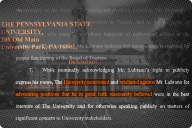You have /5 articles left.
Sign up for a free account or log in.
Colleges, for generations, have encouraged new students to "find their place" in student organizations on campus. That's bad advice, writes Lisa M. Nunn in College Belonging: How First-Year and First-Generation Students Navigate Campus Life (Rutgers University Press). Nunn, a professor of sociology and the director of the Center for Educational Excellence at the University of San Diego, writes that the traditional approach puts too much of the onus for belonging on the new student. And this approach, she writes, is particularly bad for first-generation college students.
Nunn answered questions about her book via email.
Q: What's wrong with the "find your place" message colleges typically give students?
A: The problem is that the message implicitly puts the onus on the students to find their own belonging. Yes, we do have to make some effort to join new communities or orgs; we can’t just shut ourselves up in our dorm rooms and never talk to anyone. But also, I can’t just walk up to a new group I want to be a part of, knock on the door and demand belonging. It doesn’t work like that. Belonging only happens when the group offers it to me. When they welcome me in and make a place for me. When the group makes me feel valued and important. I can’t simply go out and get belonging for myself just because I want it. It has to be given to me by a community.
So the call to “get out there and find your place” might be helpful to nudge students out the door, but it sets up an expectation that it’s my responsibility to find my own belonging. And if for some reason I don’t feel like I belong anywhere in campus life, then the message is clear: it’s my own damn fault. No matter how hard I tried to find my place, if I didn’t find it, I’m the one who failed. What my book argues is that the responsibility lies with communities for welcoming students and weaving them into the fabric of campus life. When a student feels alone and adrift, she is not the one who failed. Her campus community has failed her. It’s a sociological perspective on how communities work and how belonging works.
Q: Is that message wrong both for first-generation students and for other students?
A: What I found in 186 interviews with students on two different campuses is that continuing-generation students have a more straightforward path to belonging. It’s not perfect; there are ups and downs, and of course, college life is new for all first-year students, so there are adjustments they have to navigate. But continuing-gen students -- particularly those who are in the racial majority on their campus -- are more likely to feel at home at college more readily than first-generation students and underrepresented students of color. So, this message -- “find your place” -- doesn’t pose as big of a burden for them. Many continuing-gen students are able to dabble in a few clubs, student orgs or teams and find a couple that feel right without too much effort. For these students, campus feels like it is just teeming with other people who are similar to them, who enjoy the same activities, who care about the same issues and who seem to genuinely want them around.
First-generation students, on the other hand, more often describe “finding their place” as a struggle. Joining club after club, trying org after org, searching for a place where they feel at home, searching for people who make them feel wanted and valued. And feeling frustrated by the awkwardness and disappointment when yet another group is not the right one. As I point out in the book, these clubs and orgs and communities are withholding belonging rather than offering it. But from a student’s perspective, these feel like moments of personal failure. And rejection stings. It requires enduring courage and a great deal of effort to “find your place” when campus feels like it is teeming with people who don’t get you or aren’t interested in who you are in the first place.
Q: How does belonging differ when talking about campus social groups and academics?
A: One of the most interesting findings in this project is the way that students talk about belonging as happening in three distinct realms. There’s social belonging that takes the form of friendships as well as membership in clubs, teams or student orgs that make you feel important. The kind of group where you know you would be missed if you didn’t show up one day. There’s also campus-community belonging that takes the form of feeling comfortable in your own skin as you walk around campus; feeling that the amenities and events exist for you to enjoy, designed with you in mind. And you feel entitled to partake in them. There’s also academic belonging, which takes the form of feeling competent in your classes, like you have what it takes to keep up with others, maybe even feeling confident enough to raise your hand in class or talk to a professor one on one. Students I interviewed made it clear that having belonging in one realm does not automatically lead to belonging in any other realm, even though there is some connection among them. For example, I might have found some really great friends who are a second family to me, but when I’m walking through the student union or sitting down in class, I might still feel alienated or out of place. I might doubt whether I should be at this college at all.
Q: When the new students is a member of a minority group, how does that change belonging?
A: Many college campuses are white spaces -- certainly the two in my study are. So it’s perhaps not a surprise that underrepresented students of color described more obstacles to social belonging and campus-community belonging. They didn’t see much of their heritage reflected in campus events or curriculum. They didn’t see many of their favorite foods in the campus markets or their favorite music playing in the rec center or their favorite fashions in the bookstore. They were more likely to describe dorm roommates that made them feel invisible or irrelevant, or who eyed them suspiciously. This wasn’t the case for every student of color, of course, but these were salient parts of the college experience for some.
One important dynamic is something that came through interviews with white students. They overwhelmingly said that they value ethnoracial diversity and desire to be part of a student body that includes people from different races, ethnicities and backgrounds from themselves. However, when they talked about it, they described a kind of ideal for ethnoracial diversity in which nonwhite students would blend themselves in to campus life without making a fuss. Many white students saw it as the task of others to “integrate,” “fuse,” “mix” or “coexist” (all words that students used in interviews) without making anyone else feel uncomfortable about it.
In the book I call this a desire for nice diversity, drawing on Angelina Castagno’s ideas about the ways that niceness is foundational to whiteness. Accordingly, many ethnoracial majority students (white and, at one of my campus sites, also Asian) expressed dismay and frustration when students were part of clubs or orgs that centered on an ethnoracial identity, such as the popular Latino-Chicano Resource Center at one campus in my study. White students perceived it as divisive, exclusionary and, well, not nice, when students of color “huddle off together,” to use one respondent’s phrase, instead of blending themselves in to the larger campus culture. So, underrepresented students of color felt -- quite accurately -- a sense of distrust and a withholding of belonging from ethnoracial majority students around campus.
Q: What is your advice to colleges that want to make students welcome and to have them succeed?
A: In the book I offer nine suggestions for campuses. Let me highlight just a few here.
For starters, eliminate both discourse and thinking that encourages students to “find their place.” Replace it with welcoming messages based on the assumption that the entire campus is their place. As faculty, staff and administrators, we bear responsibility for fostering a sense of belonging for students. In order to meet their belonging needs, we need to communicate to students through our everyday interactions that they are important. The university exists because students exist.
Next, put your money where your mouth is. If you claim that first-generation students’ academic success is important to you, then support resources should be amply funded, run by highly competent staff and located in a visible, central part of campus, not tucked away in a low-trafficked corner or basement someplace. If your campus has programs it prides itself on such as community engagement or nature conservancy or artistic endeavors or something else, ensure that the programs are attractive to the entire range of your student body. Firstly by subsidizing the cost for low-income students. Secondly, if, say, first-gen participate at lower rates, ask them why. And commit to making changes that make the programs more inviting, rather than trying to convince first-gen students to find your programs desirable as they are.
I also suggest implementing practices of not only reaching out to students, but also reaching in. First-gen students, like all of us, do not know what they do not know. We can’t expect them to come up with all the right questions to ask. We need to reach out to them directly to invite them to make use of the writing center or the wellness office or the library or the academic advising office and we need to tell them exactly what that place can do for them. Further, we need to find ways to reach in, to ask how they are doing, to check in on that class they are retaking from last semester, to inquire about how well they are getting along with their roommate. Do not wait for first-gen students to come to their RA or the wellness center or a professor’s office hour with their concerns. First-gen students are impressively self-reliant and often save asking for help as a last resort. We need to create structures where someone knowledgeable checks in on individual students and helps them problem solve without being asked. We can minimize the heartache of trial and error for them that way, not to mention the hours and hours wasted on strategies to solve problems that bear no fruit. Well-timed mentorship and routines of offering unsolicited advice can make students feel cared about and important.
We are the campus community. It’s up to us to offer the gift of belonging to students.








